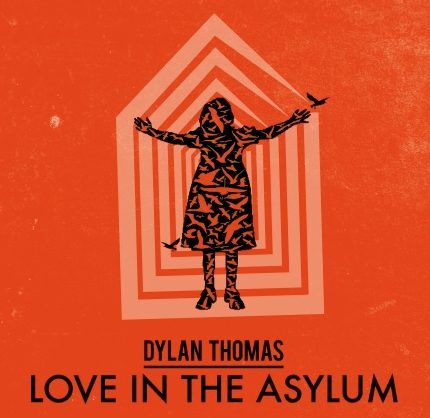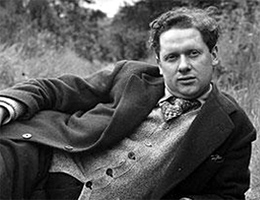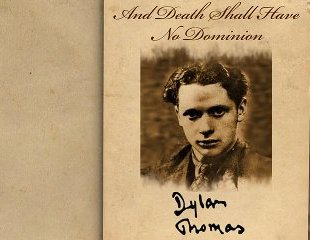Dylan Marlias Thomas, the greatest of the poets of Wales was born on 27th October 1914. He found out early that he hated academics, although he regretted it later. Dylan’s early verse style tended to unobscurity and exaggerated metaphor though he was a poet of villa and family. Dylan often set his listeners alive by his voice of elation and anguish ringing over their heads. In his own time Dylan was a myth and a legend who mesmerized large audiences through his poetry, his B.B.C. broadcasts and his recitations of his own poetry during his various lecture tours of the U.S.A. He came to be regarded as the greatest lyric poet of his age.
About the poem –
The poem was written in 1944 and published in the volume of poems – Death and Entrance (1946). It was written in the seclusion or his Welsh retreat at New Quay in Laugharne. Dylan had already exhausted the material of his four Swansea Notebooks and so the lyric is not a re-working of earlier material but an entirely fresh composition, representing the following of Dylan’s genius at the close of the war. This birthday lyric at once set the seat of critical approval on his reputation. The lyric has none of the obscurity and the abundant imagery of the poems in the earlier volumes. It can be easily understood as it is characterized by clarity and lucidity.
In his birthday poems Dylan is often seeking to ‘marvel’ time away to claim his freedom which dissociation or separateness brings. The world is ‘his’ world – it is him.
“My birthday . . .
Above the farms . . .”
The rain is a shower of all days: but this pathetic fallacy cannot be wholly sustained. He finds freedom and immediacy in relating to objects, which he imagines. But this escape into a dream-world is short lived, and reality inevitably breaks in:
“ . . . I wandered and listened
Wind blow cold. . . “
The self can relate itself with intensity only to an object which is an object of its own imagination:
“but all the gardens
. . . the larkful cloud.”
The ‘tall tales’ of imagination can make him relate himself to an imaginary world as object: but as he grows older this cannot be sustained:
“There could I marvel
My birthday
. . . from . . . country. . .”
He persists in invention, claiming his schizoid ‘freedom’ to create by fancy and imagination. He fantasizes the other air:
“And down the . . .
And the gospels. . . “
Here the free imagination, memory and the reality of the present, merge, enabling him to perceive what he perceives. He is able to see the difference between the present and the nostalgia for what he used to see, which he praises as legend and parable. He becomes a child again but in such a way as to find and place childhood. It is not that he is trying to maintain the child’s ‘freedom’ (the weather has turned round too much for that). He finds,
“The true. . .
Joy of the long . . .”
For this reason this is a deeply moving poem, in which Thomas finds both himself as a man of thirty and sees in real time the child-self of long ago;
“And the twice. . .
. . . his heart moved in mine.”
The red leaves of October are still a sign of death to him (a loss of blood): time is a loss of freedom. But in Poem in October he feels time as real; he ‘stood there then’. For a schizoid individual this is a great achievement; and we sense this in the controlled rhythm of the poem we feel it is profoundly meant, and that dissociation has been overcome. The risks are bravely faced: for once the chaos is escaped and the true self is found – with all its attendant anguish and dangers of annihilation:
O may my heart’s truth
. . . turning.”
Such a poem seems to represent a temporary experience of losing one’s own individual isolated self hood, which Laing says can be tolerated in certain circumstances by the ‘schizoid’ individual without too much anxiety: ‘It may be possible to lose oneself. . . in quasi-mystical experiences when the self feels it is merged with a not-self which may be called ‘god’ but not necessarily. Experiences of this kind enable Thomas to escape from isolation in Poem in October in two different ways. The escape from isolation is an escape from chaos: so this poem is clear and articulate.
While critics in general are in agreement that it is Thomas’s best poem, a poem which has the freshness and immediacy of the child’s vision of nature. However, the construction is peculiar but can be paraphrased easily. The oddity is that Thomas hears ‘a beckoning’; but since the word has the general sense of ‘entice’ or ‘lure’, he cannot be charged with really indecorous verbal gymnastics. The lyric is entirely lucid and clear.
The metre used for the poem is as light and easy in its movements as its theme. It is Thomas’ coming to light from darkness and this coming out or movement is lonely, slow and lyrical. This movement of light and sound in time and place depends for its precision and imprecision in part upon a loosening of rhythm, in part upon dream syntax and in part upon the stanza’s shape and concerts of vowels within it. Terminal assonance has replaced habitual dissonance or rhyme. (in the second stanza for example ‘name’, agrees with ‘days’ and ‘gates’; ‘horses’ agrees with ‘rose’, ‘road’, ‘border’, and ‘awoke’.)Internal vowels are so less symphonic : ‘of the town closed as the town awoke.’ These sounds of words and words of sound are as simple as the public image they compose.
Ultimately it can be said that not here that old contention of weird images in a private dark. Not here a speaking embryo or some burning babe or a nameless boy on the stairs. The child Dylan himself discovered by new lighting and improved by time.
Dear Readers- If this summary/analysis has helped you, kindly take a little effort to like or +1 this post or both. Make sure you like Beamingnotes Facebook page and subscribe to our newsletter so that we can keep in touch. We’ll keep informing you about stuffs that are really interesting, worth knowing and adds importance to you.
Some online learning platforms provide certifications, while others are designed to simply grow your skills in your personal and professional life. Including Masterclass and Coursera, here are our recommendations for the best online learning platforms you can sign up for today.
The 7 Best Online Learning Platforms of 2022
- Best Overall: Coursera
- Best for Niche Topics: Udemy
- Best for Creative Fields: Skillshare
- Best for Celebrity Lessons: MasterClass
- Best for STEM: EdX
- Best for Career Building: Udacity
- Best for Data Learning: Pluralsight















Comment: it butiful describe an iam sufficient for this
Not bad, but not good enough
how can it be improved?
It is not sufficient for me
could you kindly specify as to what will be sufficient for you?
Please clarify the meaning of October blood.
where is this expression pls highlight it.